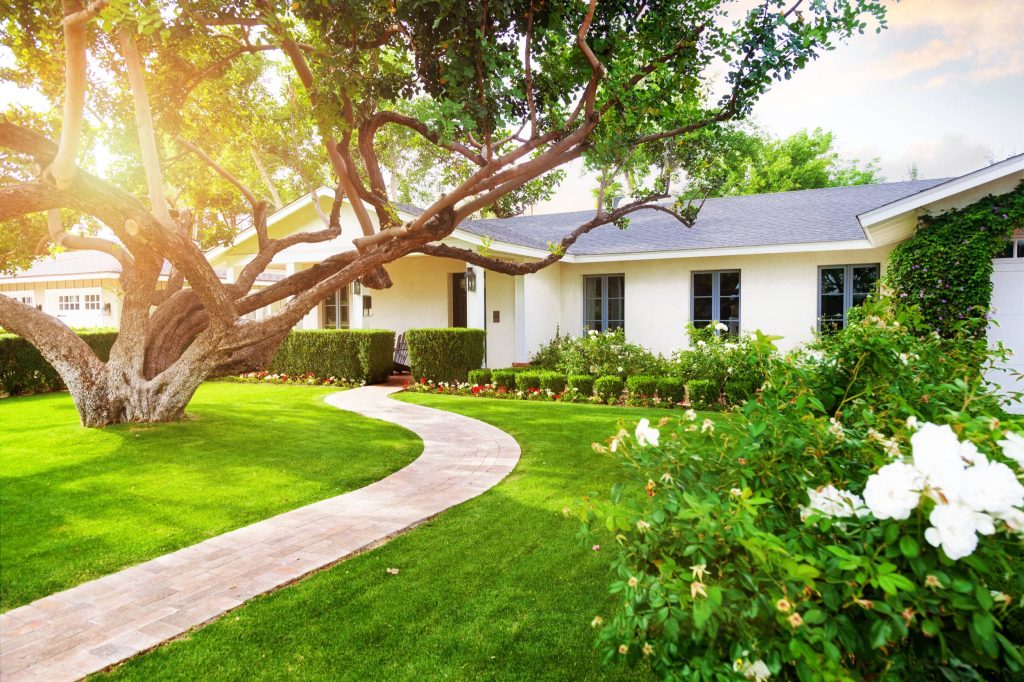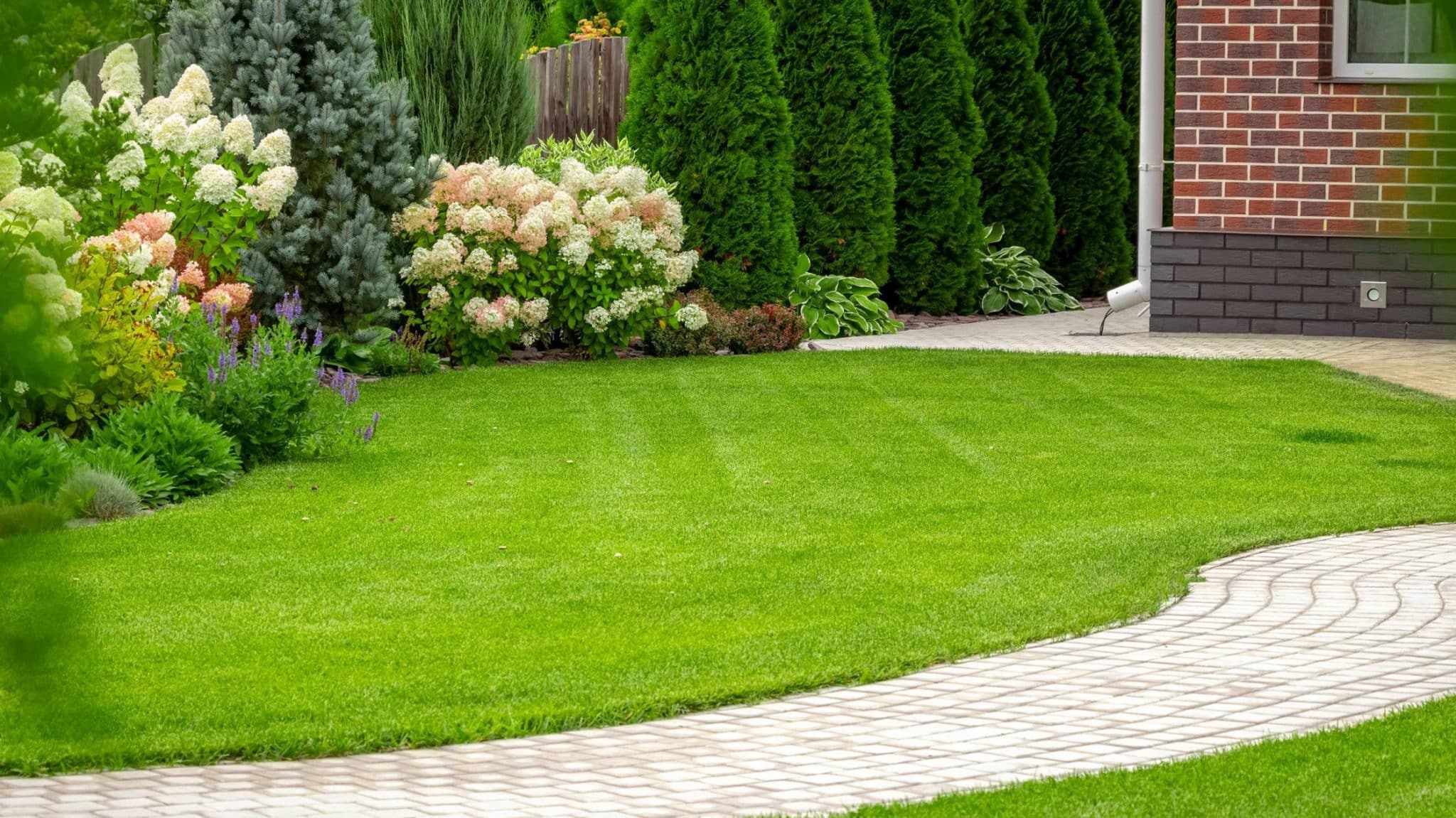
Welcome to the world of beautiful front yard landscaping, where potential meets creativity to transform your outdoor space into a stunning oasis. Landscape improvements boost a property’s curb appeal, increase home values and reduce energy costs.
This beginner guide features expert advice on all things landscaping. Read on to learn what’s required to design an enchanting landscape perfect for the climate surrounding your home.
How to Create Beautiful Landscapes
There are a variety of ways to design a stunning yard, from hardscaping to softscaping to waterscaping. Moreover, outdoor lighting can transform any front or backyard space into a serene oasis while adding functionality and security. Awareness of the climate surrounding your home and what greenery would work best are essential to every landscape design. Follow the tips below to find out how to design a landscape that reflects your style.
Add Structure with Hardscaping
Incorporating hardscaping into your yard’s design not only adds structure but also enhances the overall aesthetic appeal. Hardscaping refers to non-living features made from various materials such as wood, concrete, stones, and gravel. Examples include stone paths, decks, fences, walls, pavers, and pergolas.
Striking a balance between hardscape and softscape is essential for beautiful front yard landscaping. Hardscapes bring durability and permanence to your yard. What’s more, they define boundaries and divide functional areas while creating striking visual contrasts with plants and greenery.
Beautify a Space with Softscaping
Walkways, retaining walls, and patios are the foundation of your landscape design, while softscaping brings color and texture. Softscaping is the arrangement of greenery and plants in back and front yard landscaping. Adding foliage like shrubs, grasses, and trees into your garden or yard design breathes life into the space and provides a natural touch that effortlessly complements various architectural styles.
Design softscapes with climate in mind. For instance, drought-tolerant succulents are ideal for areas with minimal rainfall, while lush ferns need a shady spot with plenty of moisture. To further elevate visual appeal and create depth within your landscape design, blend color combinations by grouping similar hues or contrasting different shades. Aim to achieve year-round interest by combining evergreen trees with deciduous varieties that showcase seasonal changes through blooms or foliage variations.
Calming Effects of Waterscaping
Water features transform any outdoor space into a serene and calming sanctuary. Besides visual appeal, they provide an array of benefits and promote relaxation and tranquility. Beautiful front yard landscaping often includes waterscaping. Fountains and ponds are typically low maintenance and require less space than other landscape features.
Moreover, they increase property value by adding luxury and sophistication to your landscape design. With countless options available, from simple bubbling rocks to elaborate koi ponds, there’s a perfect water feature for every yard type and size.
Lighting for Ambiance and Functionality
Outdoor lighting adds ambiance and beauty to your yard and enhances security and safety Floodlights, pathway lights, or up-lights that highlight trees or bushes can be used in a variety of front and backyard designs. Professional landscapers can help you determine which kind of light fixtures work best for each area in the garden. Select a wattage that isn’t too bright, as the soft light will be visually pleasing and won’t disturb your neighbors.

Tips For Designing A Beautiful Landscape
When planning your landscape design, don’t rush. Though you may be eager to get started on the actual work, this initial phase is the most important. With careful consideration, you ensure you select the landscape that’s perfect for your home, your neighborhood, and your interests. Here are a few suggestions to get you started.
Consider The Climate And Location
The first step in designing a beautiful landscape is to evaluate the goals and needs of your space, as well as any limitations or challenges presented by the environment. Consider the climate and location of your property. Awareness of the climate variations in your location will help you determine which plants will thrive, what materials to use for hardscaping features, and what type of watering system you’ll need.
For example, if you live in an area with low rainfall or drought conditions, xeriscaping principles can help conserve water while still creating a beautiful landscape. If your yard has a lot of sun exposure, consider heat-tolerant plants like succulents or ornamental grasses. If you have areas with lots of shade, look for plants that prefer lower light conditions like ferns or hostas.
Define Your Landscape Plan
Design your yard to bring attention to specific areas and create visual interest. Start with large-scale features like hardscaping structures such as patios, walkways, and retaining walls. These designs will help define different areas within your landscape. From there, add softscaping elements like trees and shrubs for height and texture variation and include water features or sculptures to add visual interest while enhancing relaxation spaces.
Create Focal Points
Waterscaping, softscaping, and hardscaping create focal points throughout your yard. These areas are essential to design a beautiful landscape. Moreover, they bring attention to specific locations in your yard, such as an outdoor seating area.
Focal points visually organize the landscaped area and create a resting spot. For example, if you have an expansive but plain lawn, adding focal points such as fire pits or swings can help identify the role of space to meet your needs. Focal points are about design cohesion; they should complement rather than clash with other aspects of your landscape design.
Conclusion
When you transform your yard into a serene oasis, it becomes a meeting place, not merely a decoration. Besides improving the quality of life, it increases the value of your property. When you add hardscaping, softscaping, water features, and lighting into your design, it creates a stunning landscape that reflects your style.
